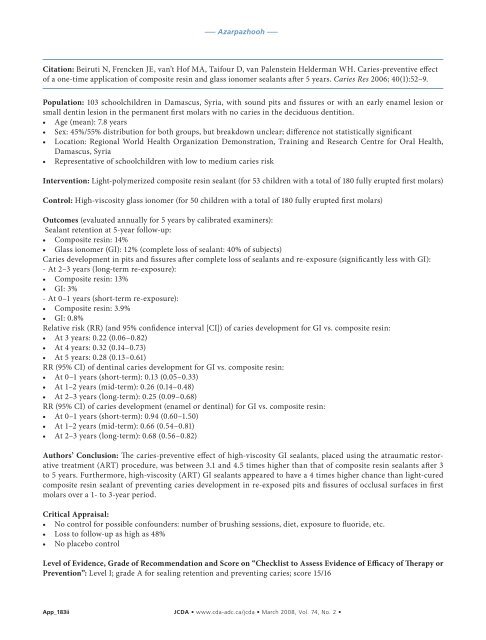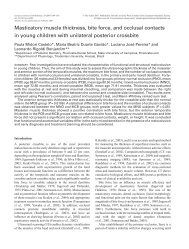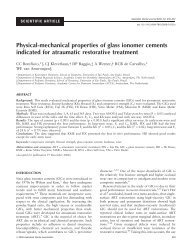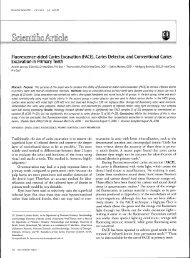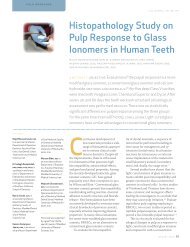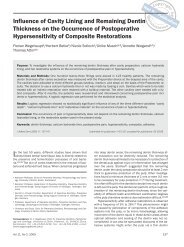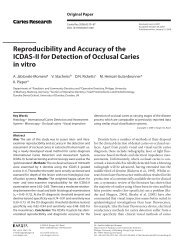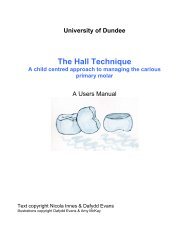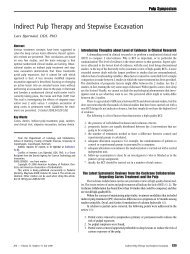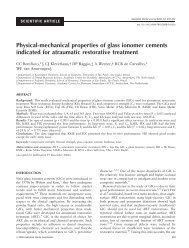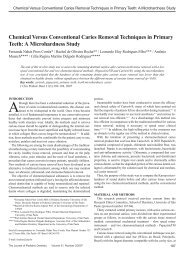Pit and Fissure Sealants in the Prevention of Dental Caries in ...
Pit and Fissure Sealants in the Prevention of Dental Caries in ...
Pit and Fissure Sealants in the Prevention of Dental Caries in ...
Create successful ePaper yourself
Turn your PDF publications into a flip-book with our unique Google optimized e-Paper software.
––– Azarpazhooh –––<br />
Citation: Beiruti N, Frencken JE, van’t H<strong>of</strong> MA, Taifour D, van Palenste<strong>in</strong> Helderman WH. <strong>Caries</strong>-preventive effect<br />
<strong>of</strong> a one-time application <strong>of</strong> composite res<strong>in</strong> <strong>and</strong> glass ionomer sealants after 5 years. <strong>Caries</strong> Res 2006; 40(1):52–9.<br />
Population: 103 schoolchildren <strong>in</strong> Damascus, Syria, with sound pits <strong>and</strong> fissures or with an early enamel lesion or<br />
small dent<strong>in</strong> lesion <strong>in</strong> <strong>the</strong> permanent first molars with no caries <strong>in</strong> <strong>the</strong> deciduous dentition.<br />
• Age (mean): 7.8 years<br />
• Sex: 45%/55% distribution for both groups, but breakdown unclear; difference not statistically significant<br />
• Location: Regional World Health Organization Demonstration, Tra<strong>in</strong><strong>in</strong>g <strong>and</strong> Research Centre for Oral Health,<br />
Damascus, Syria<br />
• Representative <strong>of</strong> schoolchildren with low to medium caries risk<br />
Intervention: Light-polymerized composite res<strong>in</strong> sealant (for 53 children with a total <strong>of</strong> 180 fully erupted first molars)<br />
Control: High-viscosity glass ionomer (for 50 children with a total <strong>of</strong> 180 fully erupted first molars)<br />
Outcomes (evaluated annually for 5 years by calibrated exam<strong>in</strong>ers):<br />
Sealant retention at 5-year follow-up:<br />
• Composite res<strong>in</strong>: 14%<br />
• Glass ionomer (GI): 12% (complete loss <strong>of</strong> sealant: 40% <strong>of</strong> subjects)<br />
<strong>Caries</strong> development <strong>in</strong> pits <strong>and</strong> fissures after complete loss <strong>of</strong> sealants <strong>and</strong> re-exposure (significantly less with GI):<br />
- At 2–3 years (long-term re-exposure):<br />
• Composite res<strong>in</strong>: 13%<br />
• GI: 3%<br />
- At 0–1 years (short-term re-exposure):<br />
• Composite res<strong>in</strong>: 3.9%<br />
• GI: 0.8%<br />
Relative risk (RR) (<strong>and</strong> 95% confidence <strong>in</strong>terval [CI]) <strong>of</strong> caries development for GI vs. composite res<strong>in</strong>:<br />
• At 3 years: 0.22 (0.06–0.82)<br />
• At 4 years: 0.32 (0.14–0.73)<br />
• At 5 years: 0.28 (0.13–0.61)<br />
RR (95% CI) <strong>of</strong> dent<strong>in</strong>al caries development for GI vs. composite res<strong>in</strong>:<br />
• At 0–1 years (short-term): 0.13 (0.05–0.33)<br />
• At 1–2 years (mid-term): 0.26 (0.14–0.48)<br />
• At 2–3 years (long-term): 0.25 (0.09–0.68)<br />
RR (95% CI) <strong>of</strong> caries development (enamel or dent<strong>in</strong>al) for GI vs. composite res<strong>in</strong>:<br />
• At 0–1 years (short-term): 0.94 (0.60–1.50)<br />
• At 1–2 years (mid-term): 0.66 (0.54–0.81)<br />
• At 2–3 years (long-term): 0.68 (0.56–0.82)<br />
Authors’ Conclusion: The caries-preventive effect <strong>of</strong> high-viscosity GI sealants, placed us<strong>in</strong>g <strong>the</strong> atraumatic restorative<br />
treatment (ART) procedure, was between 3.1 <strong>and</strong> 4.5 times higher than that <strong>of</strong> composite res<strong>in</strong> sealants after 3<br />
to 5 years. Fur<strong>the</strong>rmore, high-viscosity (ART) GI sealants appeared to have a 4 times higher chance than light-cured<br />
composite res<strong>in</strong> sealant <strong>of</strong> prevent<strong>in</strong>g caries development <strong>in</strong> re-exposed pits <strong>and</strong> fissures <strong>of</strong> occlusal surfaces <strong>in</strong> first<br />
molars over a 1- to 3-year period.<br />
Critical Appraisal:<br />
• No control for possible confounders: number <strong>of</strong> brush<strong>in</strong>g sessions, diet, exposure to fluoride, etc.<br />
• Loss to follow-up as high as 48%<br />
• No placebo control<br />
Level <strong>of</strong> Evidence, Grade <strong>of</strong> Recommendation <strong>and</strong> Score on “Checklist to Assess Evidence <strong>of</strong> Efficacy <strong>of</strong> Therapy or<br />
<strong>Prevention</strong>”: Level I; grade A for seal<strong>in</strong>g retention <strong>and</strong> prevent<strong>in</strong>g caries; score 15/16<br />
App_183ii<br />
JCDA • www.cda-adc.ca/jcda • March 2008, Vol. 74, No. 2 •


